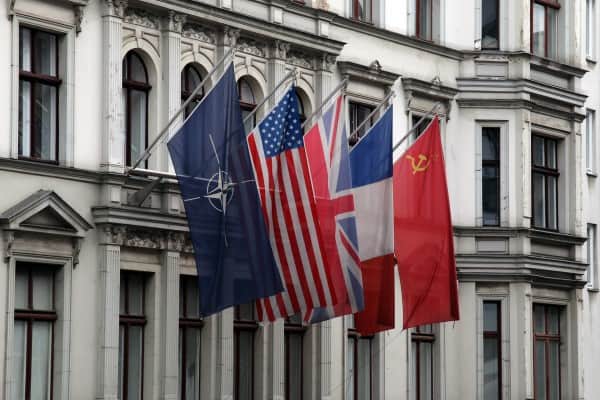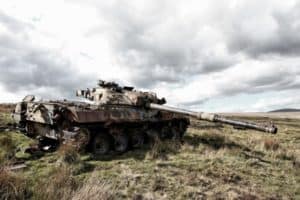This page contains affiliate links. This means if you a follow a link and make a purchase, at no additional cost to you, Humanitarian Careers will receive a commission. Thank you for supporting the site.
The United Nations and NATO are two of the most important, and powerful, international organisations in the world. Both have global reach and play a key role in world affairs. The UN and NATO also both taken military action and are important in maintaining peace. However, these organisations are very different, but how so?
The United Nations and NATO are different in many important ways. These include their different histories, mandates, structures, funding and memberships. They are also different types of organisations, differ in size and have varied budgets. The UN and NATO were founded at similar times but to achieve very different aims.
Now we know some of the key ways that NATO and the United Nations are not the same, let’s look in more detail at how, and why they differ…
Differences Between the UN and NATO: An Overview
The first major difference between the United Nations and the North Atlantic Treaty Organisation (NATO) is the type of organisation they are. The United Nations is an intergovernmental organisation. An intergovernmental organisation is made up of sovereign states who work together in their common interests. Intergovernmental organisation are given legal status and often have responsibilities for making international laws.
NATO is an international military alliance. This is very different to the UN. An international military alliance is created when states agree by treaty to defend each other in case of aggression. International military alliances also often pool the military resources of their member states. Intergovernmental organisations and international military alliances are very different types of bodies and this is a big reason the UN and NATO are not the same.
Another significant difference between NATO and the United Nations is their histories. The UN was established in 1945 after World War Two. It has 50 original member states and was designed to prevent another world war. The UN built on the previous failings of the League of Nations. On the UN Security Council sits all the victorious powers of the war, giving them significant control over global affairs.
Although NATO was also established after the Second World War – in 1949, its history is different to that of the UN’s. NATO was set-up with 12 countries from Western Europe and North America signing the treaty of establishment. NATO was designed to protect Europe in the event of an attack by the Soviet Union. It does not include all the countries that won World War Two and, in many ways, can be seen as one of the first steps in the Cold War.
Another key difference between the UN and NATO are their member states. The United Nations currently at 192 member states, meaning almost every country in the world is part of it. The UN has member states in every region of the world. Due it’s aim to be an international body of global nations, there are no geographical restrictions on members joining the UN.
NATO, on the other hand, is only open to nations in the ‘North-Atlantic’ region. Although the interpretation of the region is taken broadly, with NATO member states stretching from Canada to Turkey, a country cannot join NATO if it outside of Europe or North America. As NATO has strict geographical requirements on who can join, it is very different to the UN.
An important difference between the United Nations and NATO is how they are funded. NATO is funded through direct and indirect contributions by member states. Direct NATO funding accounts for 0.3% of each countries defence budget and goes to running NATO and as an organisation. Indirect funding to NATO comes when a country commits troops or resources to NATO missions or exercises.
The UN is not funded in the same way as NATO. The United Nations is funded by direct contributions to the organisation, and additional funding is given to specific agencies and projects. Countries pay towards the United Nations based on their GBP and economic performance. Nations can also pay additional money towards UN work that directly relates to their interests.
The size of both organisations is a further difference between them. The United Nations has around 44,000 staff worldwide. Most UN staff members are employed directly by UN agencies are a contracted to the organisation. The UN also seconds staff from member states, for example in peacekeeping missions, but these staff work under the banner of the United Nations.
In contrast, NATO has only around 4,000 permanent staff. These are spread between the headquarters, national organisations and missions. Although NATO has much less staff than the UN, because it is a military alliance it works to coordinate the armed forces of many nations. However, the people working within the armed forces contributing to NATO are not employed by it but remain members of their respective country’s armies.
Although they may seem similar, a final way that the UN and NATO are actually different is there budgets. Both organisations have a yearly budget of around three billion USD a year. However, for the United Nations, that is the amount approved by the General Assembly. The UN also receives additional funding from member states for specific projects.
NATO’s budget is similar in total amount to the United Nations. However, this is the budget for operational running of NATO’s offices, missions and programmes. As NATO is a military alliance, it also uses the combined military budgets of its member states. Although this is not money NATO can use itself, it does mean NATO has access to significantly more resources than the UN does.
Why the United Nations and NATO Are Not the Same?
There are several key reasons why the United Nations and NATO are not the same. The first is the overall aim of each organisation. The aim of NATO is to secure the collective security of member states through defensive, and, if attacked, offensive military action. It also aims to use the combined military strength of all member states as a deterrent against an attack on any single one.
In contrast, the objective of the United Nations is to work towards global peace and security through cooperation and dialogue between countries. It aims to be a forum where disputes between nations can be resolved and works for non-violent solutions to international issues. The overall aims of NATO and the UN are very different, and this is a why the two organisations are not the same.
Another key reason for the difference between NATO and the United Nations is how they are structured. The UN is made up of six main institutions – General Assembly, the Security Council, the Economic and Social Council, the Trusteeship Council and the Secretariat and the International Court of Justice. It also has a number agencies covering everything from global health, to international aviation, from refugee assistance to preserving historical sights.
The structure of NATO is completely different to that of the UN. NATO has a complex structure of military and civilian bodies designed to incorporate military and political leadership from member states and coordinate decision making. NATO is headed by the Secretary General, but the organisation includes a wide range of delegations, missions, and sub-organisations. The structures of the UN and NATO are completely different, and this is a big reason why they are not the same.
A further reason for the differences between the United Nations and NATO is that they take very different views on the use of military force. NATO is an international military alliance. It’s designed to be defensive and to act as a protection mechanism for member states. It does not take aggressive military action, but the aim of NATOs armed forces is not to peacekeeping or humanitarian action.
Alternatively, the United Nations uses military force when it is authorised by the Security Council. This can be as defensive action, such as in the Korean War, or as peacekeeping forces. The UN’s use of military force is supposed to be impartial and neutral. The UN has also given offensive mandates to its peacekeeping forces, such as in the Democratic Republic of Congo.
Another reason why the NATO and the UN are different is because of their roles in the world. The UN is seen as the international legal foundation. It passes many international laws, governs key aspects of international relations including trade, energy, tourism and conservation and can bring criminal cases against countries, institutions and individuals.
NATO has a very different role in the world than the United Nations. It is not a legal body and does not pass international laws. It is also not a governmental organisation and so does not set regulations or govern international relations. NATO is only a military alliance and it is designed so that the military forces of several nations can work together. This is an entirely different role to the UN.
A final, really important, reason for the difference between the United Nations and NATO is their impartiality. The UN acts as an international arbitrator and so must be as neutral as possible. The UN does it’s best to be impartial in conflicts, disputes and disagreements between nations. This is very different to NATO.
NATO is not a neutral or impartial organisation. The objective of NATO is to defend its member states and so it is fully one-sided in any dispute or conflict. NATO will also take the side of its member states and therefore it cannot be a neutral or impartial organisation. This is a reason why the UN and NATO are not the same.
UN And NATO Online Courses
If you want to learn more about NATO, and why it is different to the United Nations, take the online short course International Relations and Politics: The Origins of NATO. The course explores the history and founding of the North Atlantic Treaty Organisation, including its motives, context and aims. It also goes over how NATO has changed as the global international order has shifted. Click the link to be taken to the course’s page.
One thing both the UN and NATO have in common is a history of evoking international humanitarian law. In order to fully understand both organisations, we recommend the online short course International Humanitarian Law in Theory and Practice offered by Leiden University in the Netherlands. It only takes around 20 hours to complete and provides a fantastic overview of international humanitarian law and how organisations enforce it. Follow the link for more information.
Both NATO and the UN are now working in a global context that is shifting rapidly. Changes in global politics, economics, military might, and human migration have vastly altered international affairs in the last decades. In order to understand NATO and the UN and how they are adapting to these changes, we recommend the online The Changing Global Order also offered by Leiden University. Click the link to enrol.
Examples of The Differences Between NATO and the UN
In order to best explain the differences between the United Nations and NATO, let’s took at historical events and see how each organisation reacted.
The good example of how the UN and NATO are different is the Bosnian War. The UN formed a peacekeeping mission in Bosnia in 1992. However, it’s mandate was to create safe havens for civilians. However, the UN famously failed to protect civilians during the Srebrenica Massacre and is widely blamed for being unable to end the conflict.
In contrast to the UN’s operations in Bosnia, NATO played a key role in ending the conflict. NATO took action against Serbian forces from 1995. NATO famously broke the siege of Sarajevo and is widely credited with being the deciding factor that ended the war. This is very different to the UN who had a three-year presence in Bosnia and were unable to stop the violence.
Another good example of the differences between NATO and the United Nations is their respective roles in Afghanistan. After the 9/11 attacks on America, the US activated NATO Article 5, meaning collectively the alliance would use its military force to invade Afghanistan. This saw NATO take military action to remove the Taliban regime and go after Al-Qaeda.
In 2002 the United Nations established UNAMA – the UN mission in Afghanistan. This was tasked with assisting to rebuild Afghanistan after the fall of the Taliban and assisting with peace building and security. This UN mission in Afghanistan is very different to the NATO operation as it aims to assist Afghanistan to rebuild and provides humanitarian assistance to the Afghan people.
The UN mission in the Democratic Republic of Congo (DRC) is another example of how the organisation is not the same as NATO. The UN has had a presence in the DRC since the 1960s but following growing violence in the east of the country, additional UN peacekeepers were deployed. The UN peacekeeping mission in the eastern DRC was the first to be given an offensive mandate, allowing them to actively pursue rebel groups and take pro-active military action.
The big difference between the UN mission in the eastern DRC and any NATO missions is that the UN was authorised to take offensive action. Although this is not usual for UN peacekeeping missions, it makes a key separation from NATO. As a defensive military alliance, NATO does not take action as an aggressive force but only in the defence of member states.
A key point in history that can be used as an example of how the UN and NATO are not the same is the end of the Cold War. With the collapse of the Soviet Union and the fall of regimes in eastern Europe between 1989 and 1991, NATO began expanding to include former communist countries. Poland, Estonia, Lithuania, Latvia, Bulgaria, Romania, Slovakia, Slovenia, Albania, Croatia, Montenegro, and North Macedonia are all former communist countries that have joined NATO since the end of the Cold War.
The expansion of NATO to the east since the fall of Soviet Union is very different to how the UN responded to the end of the Cold War. Most communist countries were already UN member states and so the UN did not expand much following the fall of communism. Some post-Soviet states, such as Estonia, Latvia and Lithuania did join the UN as new member states, but the UN did not see sustained and progressive expansion like NATO did after the end of the Soviet Union Europe.
A further example of how the UN and NATO are not the same is the UN mission in Cyprus. Following the Turkish invasion in 1974, the island of Cyprus was divided between Greek and Turkish communities. The UN peacekeeping mission in Cyprus is designed to maintain the peace and prevent a return to conflict.
The UN mission in Cyrus is different to any NATO mission because it is designed to act as force preventing the restarting of the war. NATO missions take defensive actions against states or perceived threats. This is very different to peacekeeping. Importantly, UN peacekeeping missions are often not mandated to enforce peace, but to monitor and maintain it. This is also in contrast to NATO.
A final example of how NATO and the United Nations are not the same is the NATO mission in Iraq. The terror group ISIS captured large parts of Iraq in 2014. NATO responded with an intervention assisting Iraqi ground forces to push ISIS back. NATO countries committed extensive air-support, as well as training and special forces operations, to help Iraq defeat ISIS.
The United Nations mission in Iraq, in contrast, is focused on humanitarian aid, peacebuilding and development. The UN in Iraq did not take offensive military action against ISIS. In fact, the UN does not have a mandate to station troops in Iraq. The roles of the UN and NATO in Iraq are completely different, and this highlights how the two organisations play very contrasting roles in the world.
If you want to learn more about the United Nations, and how it differs to NATO, explore our list of the top UN online courses here.





